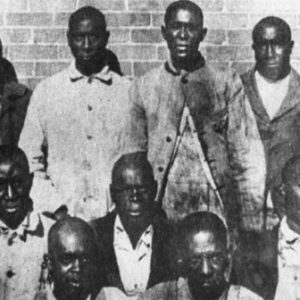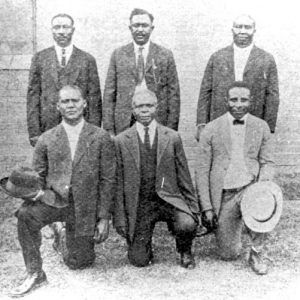calsfoundation@cals.org
Ed Hicks (1873–?)
Ed Hicks was one of twelve African-American men accused of murder following the Elaine Massacre of 1919. After brief trials, the so-called Elaine Twelve—six who became known as the Moore defendants (including Ed Hicks and his brother Frank) and six who became known as the Ware defendants—were found guilty of murder and sentenced to death. The appeal of his and others’ sentences led to the U.S. Supreme Court case of Moore v. Dempsey. Ultimately, the Ware defendants were freed by the Arkansas Supreme Court in 1923; after numerous legal efforts, the Moore defendants were released in 1925.
Ed Hicks was born on December 23, 1873, in Dublin County, North Carolina, to Lucy Hicks. Hicks and his wife, Mattie Hicks, married in 1898 and had previously had a daughter. The couple welcomed a son in 1899; a daughter, Bessie, in 1900; and a third daughter in 1903. By 1910, Ed and Mattie Hicks were living in Bolivar County, Mississippi. Hicks was again living in North Carolina and working as a farmer in 1918 when he registered for the World War I draft. By 1919, Hicks had returned to Arkansas and was living with his wife, Arrieta, and their three daughters. He farmed 100 acres of land that he was renting from Stanley and Moore Brothers. Hicks shared the land with his brother Frank and planted corn and cotton on his seventy acres. According to tax records, their crops were valued at $22,500, and, at the time of the Elaine Massacre, Ed Hicks owned four mules, a wagon, farming tools, and his wife’s clothing.
Ed Hicks was considered one of the ringleaders of the events that prompted the massacre, as he and his brother Frank were leaders of the Elaine (Phillips County) chapter of the Progressive Farmers and Household Union of America (PFHUA), the group whose meeting ignited the events that culminated in the massacre. Hicks was present a union meeting at the Hoop Spur church outside of Elaine when shooting broke out on September 30, 1919. After being wounded during the massacre and treated at the hospital, Hicks was transferred to jail. Unlike many others in her position, Hicks’s wife was able to get back some of her household goods after the situation had calmed down, receiving her hogs, her chickens, and a horse. However, she received no money for the crops.
On October 31, a total of 122 black men were indicted by the Phillips County Grand Jury for their part in the riots. Judge J. M. Jackson began the trials on November 3. On this day, the six Moore defendants—Frank Moore, Ed and Frank Hicks, Joe Knox, Paul Hall, and Ed Coleman—were all tried for the murder of Clinton Lee. Frank Hicks was tried first, as he had been accused of shooting Lee, although one white witness, Tom Faulkner, could not identify Hicks as the shooter. According to newspaper reports, the jury took just eight minutes to deliberate over Frank Hicks’s trial before finding him guilty of murder. The remaining five men, including Ed Hicks, were tried together as accessories to murder and found guilty. All six were sentenced to death, as were the six defendants in the separate Ware case.
The cases drew the attention of the National Association for the Advancement of Colored People (NAACP), which galvanized support for the defendants and raised money for their legal counsel. It was in the defense of the Elaine Twelve that African-American attorney Scipio Jones rose to national acclaim. After a series of legal maneuvers and appeals, on February 19, 1923, the U.S. Supreme Court handed down its 6–2 decision in favor of the Moore defendants. The justices held that, considering the original trials had been mob dominated, the “corrective process afforded to the petitioners…does not seem sufficient,” and in such circumstances, federal judges had jurisdiction to overturn state criminal verdicts to rectify judicial failures of the state and to ensure that the defendants were granted due process.
Despite a favorable ruling from the U.S. Supreme Court, the case was not over; indeed, the Court had called for a re-hearing in the district court. The Moore defendants were still in jail and could have faced a re-trial. However, Jones moved to evade any more trials and have the men released from jail. On November 3, 1923, Arkansas governor Thomas McRae, following a petition in Phillips County, announced that he had commuted the death sentences to twelve years in prison, making the men eligible for parole, as they had served a third of that time. It was not until January 14, 1925, however, that the six Moore defendants were finally freed from jail, having been granted indefinite furloughs from McRae the day before. The Ware defendants had been released in 1923.
Ed Hicks’s whereabouts after his 1925 release are unknown.
For additional information:
Cortner, Richard C. A Mob Intent on Death: The NAACP and the Arkansas Riot Cases. Middletown, CT: Wesleyan University Press, 1988.
Pruden, William H., III. “Cracking Open the Door: Moore v. Dempsey and the Fight for Justice.” In The Elaine Massacre and Arkansas: A Century of Atrocity and Resistance, 1819–1919, edited by Guy Lancaster. Little Rock: Butler Center Books, 2018.
Stockley, Grif, Brian K. Mitchell, and Guy Lancaster. Blood in Their Eyes: The Elaine Massacre of 1919. Rev. ed. Fayetteville: University of Arkansas Press, 2020.
Wells, Ida B. “The Arkansas Race Riot.” Online at https://archive.org/details/TheArkansasRaceRiot/page/n1 (accessed September 24, 2019).
Whayne, Jeannie M. “Low Villains and Wickedness in High Places: Race and Class in the Elaine Riots.” Arkansas Historical Quarterly 58 (Autumn 1999): 285–313.
Whitaker, Robert. On the Laps of Gods: The Red Summer of 1919 and the Struggle for Justice That Remade a Nation. New York: Crown, 2008.
Brian K. Mitchell
Kathryn M. Bryles
Andrew A. McClain
Jessica Parker
University of Arkansas at Little Rock








Comments
No comments on this entry yet.